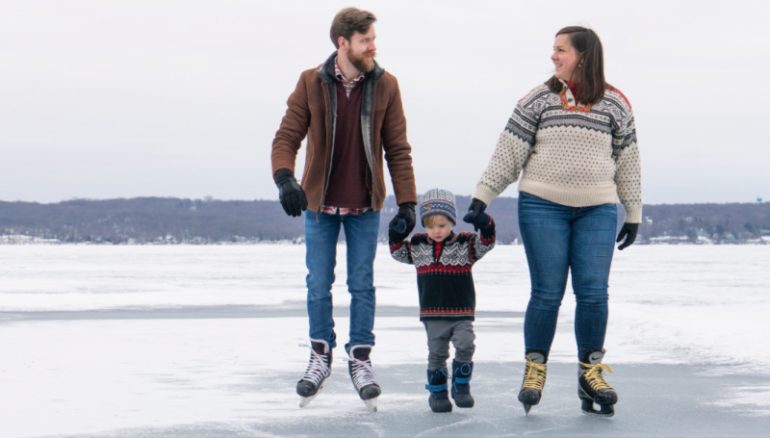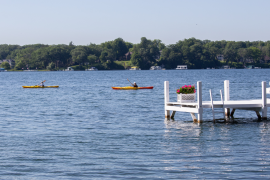By Nat Wexler | Photo by Holly Leitner
There is nothing like the feeling of standing up on a pair of skates and gliding across a frozen surface in the brisk sunshine. Ice skating is a fun winter activity for all ages, and in the Geneva Lake area, there are several ice skating opportunities perfect for everyone from the seasoned pro to the complete novice. We’ve rounded up the best places to skate, as well as tricks, tips and safety information — everything you need to know in order to have a fun, safe ice skating adventure this winter!
WHERE TO SKATE
- Grand Geneva Resort and Spa (7036 Grand Geneva Way, Lake Geneva) maintains a large, outdoor ice rink next to their ski chalet. Operation of this outdoor rink is dependent on the weather, but it typically opens toward the end of December and closes at the end of the ski season in March. The rink operates in 1 1/2-hour time slots. You can purchase tickets for a time slot online for $5, and rent skates onsite for an additional $10.
- The Williams Bay Recreational Department (Williams Bay) hosts a free ice rink on the lake, in front of the Williams Bay Boat Launch parking lot. The rink is open when a green flag is displayed, and closed when a red flag is displayed. Weather permitting, the rink is expected to open around New Year’s Day and will stay open from 9 a.m. to 9 p.m. daily.
- The Abbey Resort (269 Fontana Blvd., Fontana) turns its Harbor Patio into an outdoor ice-skating rink on certain days during the winter months. (Call for availability.) Skate rentals are free for the resort’s guests, while the general public can rent skates for $2 a pair. All participants must sign a waiver with the activity office before skating.
- Geneva Lake, Delavan Lake and Lake Como can be used for ice skating when the ice is thick enough, and proper safety techniques are followed. Generally, Lake Como freezes hard first, due to its shallow depth, followed by Delavan Lake and then Geneva Lake. Do your research first — many people use a benchmark of at least four consistent inches of ice for ice skating.
TIPS AND TRICKS FOR ICE SKATING
- Make sure your skates fit properly. Skates should fit snuggly and not allow the foot to move around inside them. Figure skaters will want to wear a medium- thickness sock to reduce the chance of blisters and keep their feet warm, while those using hockey skates can wear a thinner sock, as hockey skates are more insulated than figure skates.
- Dress in layers. Skating is an active sport, so it is essential to wear layers. You can remove layers to maintain a comfortable temperature and avoid overheating as you warm up.
- Wear wrist guards. Beginners might want to wear wrist guards, such as those used for skateboarding or rollerskating, to reduce the chance of injury in the event of a fall.
- Follow the flow of the rink. When skating on a rink with others, follow the flow of traffic to reduce the chance of a collision. If you are skating on a rink with no traffic flow, use extra caution to avoid a collision.
- Fall correctly. If you take a spill, try to fall on your side instead of forward or backward. Avoid grabbing onto somebody as you fall, since this can increase the risk of serious injury.
- Ask for a skate helper. Some rinks (like the one at Grand Geneva) have “skate helpers” available, a device the skater can hold onto that assists with balance and reduces the risk of falling.
- Have fun! Ice skating is a fun activity; enjoy the experience!
After you get a little outdoor exercise this winter, warm up with a cup of hot chocolate (extra marshmallows) while sitting in front of a roaring fire. We can’t think of a better way to spend a winter day.
SAFETY TIPS
If you are skating (or even walking!) on the frozen lake, remember to exercise extreme caution as ice thickness and stability can vary in different parts of the same body of water. The Wisconsin Department of Natural Resources recommends the following safety tips to anyone who is venturing out onto the ice:
- Don’t go alone. Even if you are with others, ensure you have a working cell phone and that somebody on land knows your location.
- Go during the day. You must be able to see and assess the ice thickness, which is why it is dangerous to be on the ice at night or during low-visibility periods.
- Clear ice is better. The strongest ice is generally ice that does not have snow on it or bubbles in it.
- Bring safety supplies in case of an emergency. Carry a charged cell phone in a waterproof case or bag, a life jacket, a length of rope and an ice claw or pick.
- Use caution and common sense. Ice freezes very unevenly. It is vital to be aware of your surroundings and use caution and common sense anytime you step onto the ice and if you move to a new area. Just because one area is safe does not mean the space next to it is.





